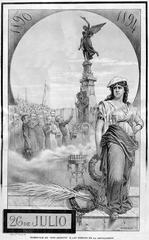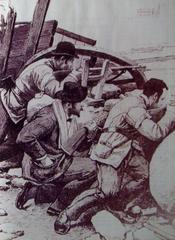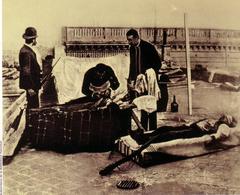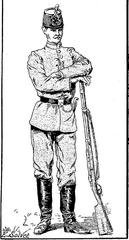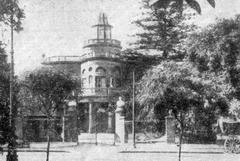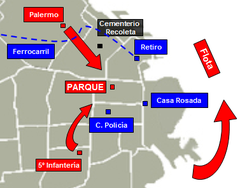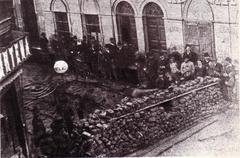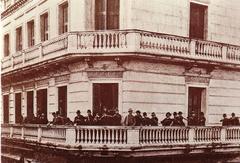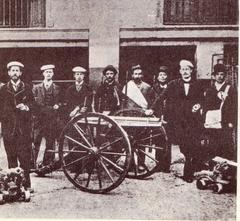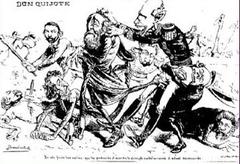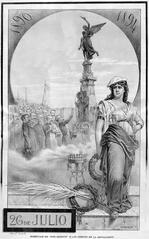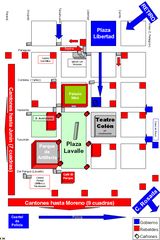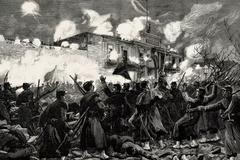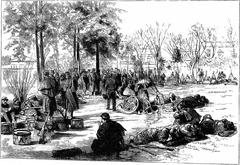
Revolution of the Park, Buenos Aires: Visiting Hours, Tickets, and Historical Significance
Date: 14/06/2025
Introduction
The Revolution of the Park Monument in Buenos Aires stands as a powerful symbol of Argentina’s ongoing struggle for democracy and political reform. Commemorating the 1890 uprising against the National Autonomist Party (PAN), the monument marks a pivotal moment when citizens challenged entrenched corruption and pressed for representative government. Located in the historic Artillery Park (Parque de Artillería), near landmarks like Plaza de Mayo and Avenida de Mayo, the site offers an immersive experience into Argentina’s socio-political evolution and the rise of modern political activism (Wikipedia: Revolution of the Park; Historica Fandom).
Known as “the Paris of South America,” Buenos Aires was the center of Argentina’s political and cultural activity during the late 19th century. The Revolution of the Park emerged in response to widespread economic hardship, electoral fraud, and social unrest under President Miguel Ángel Juárez Celman. Led by the Civic Union and figures such as Leandro Alem and Bartolomé Mitre, the unsuccessful military uprising nonetheless triggered significant political change, including Juárez Celman’s resignation and the initiation of democratic reforms (Introducing Buenos Aires; Vamos Spanish).
Visiting the Revolution of the Park Monument allows guests to connect with this enduring legacy of civic engagement and the ongoing quest for justice and democratic values in Argentina. This guide details visiting hours, ticketing, accessibility, guided tours, and nearby attractions, ensuring a rewarding experience for history enthusiasts and travelers alike (Turismo Buenos Aires; Official Buenos Aires Tourism).
Table of Contents
- Historical Background
- The Revolution of the Park: July 1890
- Outcomes and Historical Significance
- Visiting the Monument and Artillery Park
- Visuals and Interactive Elements
- Frequently Asked Questions (FAQ)
- Conclusion and Recommendations
Historical Background
Colonial and Early National Context
Buenos Aires’ importance as Argentina’s political and economic capital traces back to the colonial era. As the focal point of the Viceroyalty of the Río de la Plata (established in 1776), the city was governed by Spanish-born elites, while local creoles were marginalized (Vamos Spanish). Inspired by Enlightenment ideals and global revolutions, Buenos Aires played a central role in the May Revolution of 1810—an event that ousted the Spanish viceroy and led to the first autonomous government, the Primera Junta. This movement culminated in Argentina’s formal independence in 1816.
Political Evolution and the Generation of ’80
After independence, Buenos Aires became the capital of a unified Argentina in 1862 (Introducing Buenos Aires). The 19th century was marked by conflict between Federalists and Unitarians, shaping the city’s political identity. By the late 1800s, the “Generation of ’80” ushered in modernization and economic expansion, dominated by the National Autonomist Party (PAN). This period saw the city’s population soar due to European immigration and urban development, earning it the nickname “the Paris of South America.” However, political power remained concentrated among the elite, facilitated by electoral fraud and patronage (Introducing Buenos Aires).
Socio-Economic Tensions and the Road to Revolution
Beneath the city’s modern veneer, social and economic disparities grew. Widespread discontent arose from high inflation, economic instability, and exclusion from political processes (Wikipedia: Revolution of the Park). President Juárez Celman’s administration epitomized oligarchic rule and corruption, prompting the Civic Union—led by Leandro Alem, Bartolomé Mitre, and Aristóbulo del Valle—to mobilize for genuine democracy (Historica Fandom).
The Revolution of the Park: July 1890
The immediate trigger for the revolution was the economic crisis of 1889–1890. On July 26, 1890, Civic Union-aligned forces—around 3,000 strong—rose at Artillery Park, hoping for broader support from sympathetic military leaders (Historica Fandom). Government troops, led by Vice President Carlos Pellegrini and Generals Roque Sáenz Peña and Nicolás Lavalle, quickly suppressed the rebellion after several days of fierce fighting. Notably, the government’s harsh response, including mass arrests, further eroded its legitimacy.
Outcomes and Historical Significance
While the uprising was militarily defeated, it had profound political repercussions. President Juárez Celman resigned on August 6, 1890, succeeded by Carlos Pellegrini (Wikipedia: Revolution of the Park). The revolution exposed the vulnerabilities of oligarchic rule and set the stage for future reforms. The Civic Union’s manifesto called for republican principles, representative governance, and clean administration. The revolution inspired subsequent movements and ultimately contributed to crucial reforms, such as the Sáenz Peña Law of 1912, which established secret, universal male suffrage (Wikipedia: Revolution of the Park).
Visiting the Revolution of the Park Monument and Artillery Park
Location and Access
Located in the downtown Tribunales neighborhood, the monument is situated within Artillery Park, close to Avenida de Mayo and Plaza de Mayo. The site is easily accessible by public transportation, including the Subte (Metro) Line A (Plaza de Mayo station) and Line D (Tribunales station).
Visiting Hours & Admission
- Park Hours: Open daily, 8:00 AM to 6:00 PM.
- Admission: Free entry; no tickets required.
Guided Tours & Visitor Tips
- Guided Tours: Available through Buenos Aires tourism services and local operators. These tours offer historical context and insights into the monument and surrounding landmarks.
- Best Time to Visit: Weekday mornings for a quieter experience.
- What to Bring: Comfortable walking shoes, camera, and water bottle.
Accessibility
Artillery Park is wheelchair-accessible, with paved paths and ramps. For special accommodations, contact your tour provider in advance.
Nearby Attractions
- Casa Rosada: Argentina’s presidential palace.
- Plaza de Mayo: The historic main square.
- Palacio de Tribunales: The city’s Palace of Justice.
- Librería de Ávila: A historic bookstore with revolutionary connections.
Visuals and Interactive Elements
- Image: Revolution of the Park Monument at Artillery Park, Buenos Aires (alt text: “Revolution of the Park Monument at Artillery Park Buenos Aires”)
- Image: Historic pathways near Artillery Park (alt text: “Historic streets near Artillery Park Buenos Aires”)
For virtual tours and high-resolution images, visit Turismo Buenos Aires.
Frequently Asked Questions (FAQ)
Q: What are the visiting hours?
A: The park is open daily from 8:00 AM to 6:00 PM.
Q: Is there an entrance fee?
A: No, entry is free.
Q: Are guided tours available?
A: Yes, through local tour operators and the official Buenos Aires tourism office.
Q: Is the site accessible for visitors with disabilities?
A: Yes, there are wheelchair-accessible paths and ramps.
Q: What nearby attractions should I visit?
A: Casa Rosada, Plaza de Mayo, and Palacio de Tribunales are all within walking distance.
Conclusion
The Revolution of the Park Monument and Artillery Park are essential destinations for anyone seeking to understand Argentina’s path toward democracy. They offer a tangible connection to the struggles for political participation and social justice that continue to shape Buenos Aires. With free admission, central location, and proximity to other historic sites, the monument is a must-visit for history buffs and curious travelers alike.
For updated information, guided tour bookings, and curated itineraries, visit the official Buenos Aires tourism website or consider downloading the Audiala app for personalized travel recommendations. Embrace the opportunity to experience the legacy of the Revolution of the Park firsthand.
Sources and Further Reading
- Wikipedia: Revolution of the Park
- Historica Fandom: Revolution of the Park
- Introducing Buenos Aires: History
- Vamos Spanish: Independence Day of Argentina
- Turismo Buenos Aires: Historic Quarter
- Official Buenos Aires Tourism
- Wikipedia: Revolución del Parque
- Infobae Article on the Revolution
- Turismo Buenos Aires: Plaza de Mayo
- LACGEO: Plaza de Mayo
- Wander Argentina: Plaza de Mayo
- History Hit: Plaza de Mayo
- Globetrotter Girls: Guide to Buenos Aires
- The Crazy Tourist: 25 Best Things Buenos Aires
- Travellers Worldwide: Best Time to Visit Buenos Aires
- Journeyable: Accessible Travel Buenos Aires
- The Broke Backpacker: Is Buenos Aires Safe?
- Worldly Adventurer: Is Buenos Aires Safe?
- Planetware: Buenos Aires Tourist Attractions
- Rove.me: May Revolution Day
- Wanderlog: Buenos Aires in June
